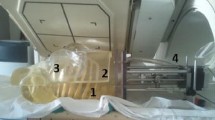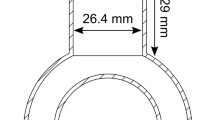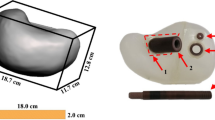Abstract
Background
The aim of this study was to determine the impact of respiratory motion correction on SPECT MPI and on defect detection using a phantom assembly.
Methods
SPECT/CT data were acquired using an anthropomorphic phantom with inflatable lungs and with an ECG beating and moving cardiac compartment. The heart motion followed the respiratory pattern in the cranio-caudal direction to simulate normal or deep breathing. Small or large transmural defects were inserted into the myocardial wall of the left ventricle. SPECT/CT images were acquired for each of the four respiratory phases, from exhale to inhale. A respiratory motion correction was applied using an image-based method with transformation parameters derived from the SPECT data by a non-rigid registration algorithm. A report on defect detection from two physicians and a quantitative analysis on MPI data were performed before and after applying motion correction.
Results
Respiratory motion correction eliminated artifacts present in the images, resulting in a uniform uptake and reduction of motion blurring, especially in the inferior and anterior regions of the LV myocardial walls. The physicians’ report after motion correction showed that images were corrected for motion.
Conclusions
A combination of motion correction with attenuation correction reduces artifacts in SPECT MPI. AC-SPECT images with and without motion correction should be simultaneously inspected to report on small defects.










Similar content being viewed by others
Abbreviations
- SPECT:
-
Single-photon emission computed tomography
- CT:
-
Computed tomography
- AC:
-
Attenuation correction
- MPI:
-
Myocardial perfusion imaging
- PLC:
-
Programmable logic controller
- MC:
-
Motion correction
- LV:
-
Left ventricle
References
Goetze S, Brown TL, Lavely WC, Zhang Z, Bengel FM. Attenuation correction in myocardial perfusion SPECT/CT: Effects of misregistration and value of reregistration. J Nucl Med 2007;48(7):1090-5.
Fricke H, Fricek E, Weise R, Kammeier A, Lindner O, Burchert W. A method to remove artifacts in attenuation-corrected myocardial perfusion SPECT introduced by misalignment between emission scan and CT-derived attenuation maps. J Nucl Med 2004;45:1619-25.
Pitman AG, Kalff V, Van-Every B, Risa B, Barnden LR, Kelly MJ. Effect of mechanically simulated diaphragmatic respiratory motion on myocardial SPECT processed with and without attenuation correction. J Nucl Med 2002;43:1259-67.
Tsui BMW, Segars WP, Lalush DS. Effects of upward creep and respiratory motion in myocardial SPECT. IEEE Trans Nucl Sci 2000;47:1192-5.
Wheat JM, Currie GM. Impact of patient motion on myocardial perfusion SPECT diagnostic integrity: Part 2. J Nucl Med Technol 2004;32:158-63.
Yang YW, Chen JC, He X, Wang SJ, Tsui BM. Evaluation of respiratory motion effect on defect detection in myocardial perfusion SPECT: A simulation study. IEEE Trans Nucl Sci 2009;56:671-6.
Segars WP, Tsui BMW. Study of the efficacy of respiratory gating in myocardial SPECT using the new 4DNCAT phantom. IEEE Nucl Sci 2002;49:675-9.
Kovalski G, Israel O, Keidar Z, Frenkel A, Sachs J, Azhari H. Correction of heart motion due to respiration in clinical myocardial perfusion SPECT scans using respiratory gating. J Nucl Med 2007;48:630-6.
Könik A, Kikut J, Lew R, Johnson K, King MA. Comparison of methods of acquiring attenuation maps for cardiac SPECT in the presence of respiratory motion. J Nucl Cardiol 2013;20:1093-107.
Ko C, Wu Y, Cheng M, Yen R, Wu W, Tzen K. Data-driven respiratory motion tracking and compensation in CZT cameras: A comprehensive analysis of phantom and human images. J Nucl Cardiol 2015;22:308-18.
Livieratos L, Rajappan K, Stegger L, Schafers K, Bailey DL, Camici PG. Respiratory gating of cardiac PET data in list-mode acquisition. Eur J Nucl Med Mol Imaging 2006;33:584-8.
Chrysanthou-Baustert I, Parpottas Y, Demetriadou O, Christofides S, Yiannakkaras C, Kaolis D, et al. Diagnostic sensitivity of SPECT myocardial perfusion imaging using a pumping cardiac phantom with inserted variable defects. J Nucl Cardiol 2013;20(4):609-15.
Cook LB. Rebreathing in the Mapleson A, C, and D breathing systems with sinusoidal and exponential wavefronts. Anaeshesia 1997;52:1182-94.
Rosset A, Spadola L, Ratib O. OsiriX: An open-source software for navigating in multidimensional DICOM images. J Digit Imaging 2004;17(3):205-16.
McLeish K, Hill DL, Atkinson D, Blackall JM, Razavi R. A study of the motion and deformation of the heart due to respiration. IEEE Trans Med Imaging 2002;21(9):1142-50.
Hesse B, Kristina-Tägil A, Cuocolo C, Anagnostopoulos M, Bardies J, Bax F, et al. EANM/ESC procedural guidelines for myocardial perfusion imaging in nuclear cardiology. Eur J Nucl Med Mol Imaging 2005;32(7):855-97.
Buerger C, Schaeffter T, King AP. Hierarchical adaptive local affine registration for fast and robust respiratory motion estimation. Med Image Anal 2011;15:551-64.
Axel M, Zikic D, Botnar R, Bundschuh R, Howe W, Ziegler S, et al. Dual cardiac-respiratory gated PET: Implementation and results from a feasibility study. Eur J Nucl Med Mol Imaging 2007;34(9):1447-54.
Masood Y, Liu Y-H, DePuey G, Taillefer R, Araujo LI, Allen S, et al. Clinical validation of SPECT attenuation correction using x-ray computed tomography-derived attenuation maps: Multicenter clinical trial with angiographic correlation. J Nucl Cardiol 2005;12:676-86.
Acknowledgments
We gratefully acknowledge the Nuclear Medicine Department of the Nicosia General Hospital (Andreas Mormoris, Chariklia Christodoulou, Lambros Lambrou, Charoula Charalambous) for helping in acquisitions. We also thank Guy’s and St Thomas Hospitals NHS Foundation Trust (Steve Turner, Bill Stevens) for optimizing the cardiac holder. The Project ΥΓΕΙΑ/ΔΥΓΕΙΑ/0311(ΒΙΕ)/27, with Host Organization the Frederick Research Center and Partner Organizations the Cyprus Ministry of Health and the King’s College London, was co-financed by the European Regional Development Fund and the Republic of Cyprus through the Research Promotion Foundation.
Disclosure
The authors declared that they have no conflict of interest.
Author information
Authors and Affiliations
Corresponding author
Rights and permissions
About this article
Cite this article
Polycarpou, I., Chrysanthou-Baustert, I., Demetriadou, O. et al. Impact of respiratory motion correction on SPECT myocardial perfusion imaging using a mechanically moving phantom assembly with variable cardiac defects. J. Nucl. Cardiol. 24, 1216–1225 (2017). https://doi.org/10.1007/s12350-015-0323-0
Received:
Accepted:
Published:
Issue Date:
DOI: https://doi.org/10.1007/s12350-015-0323-0




